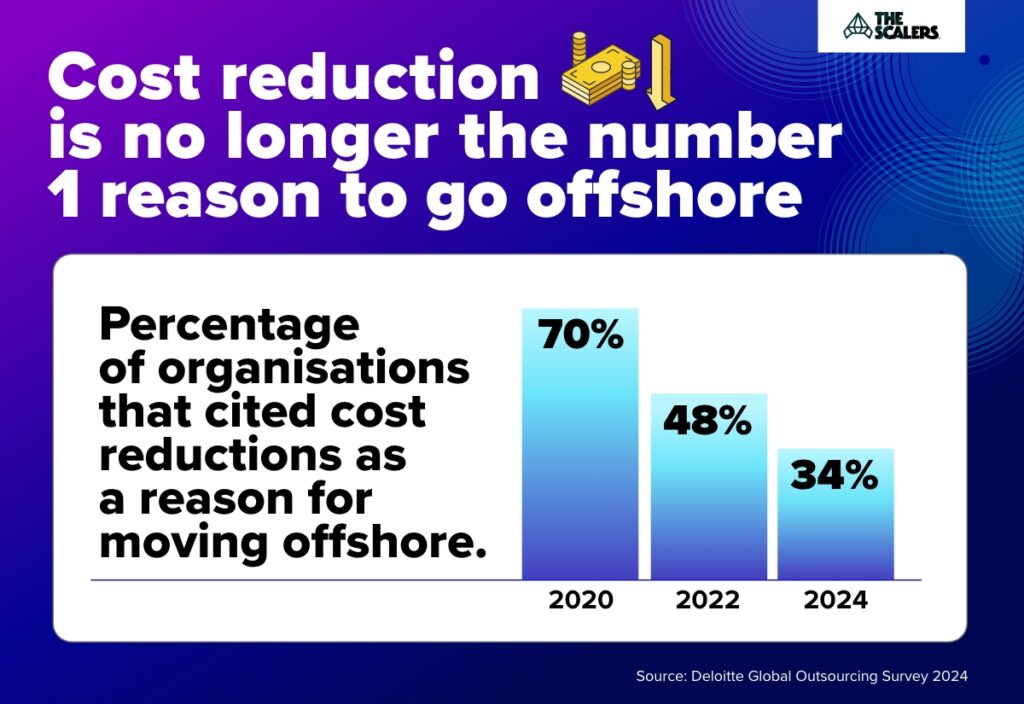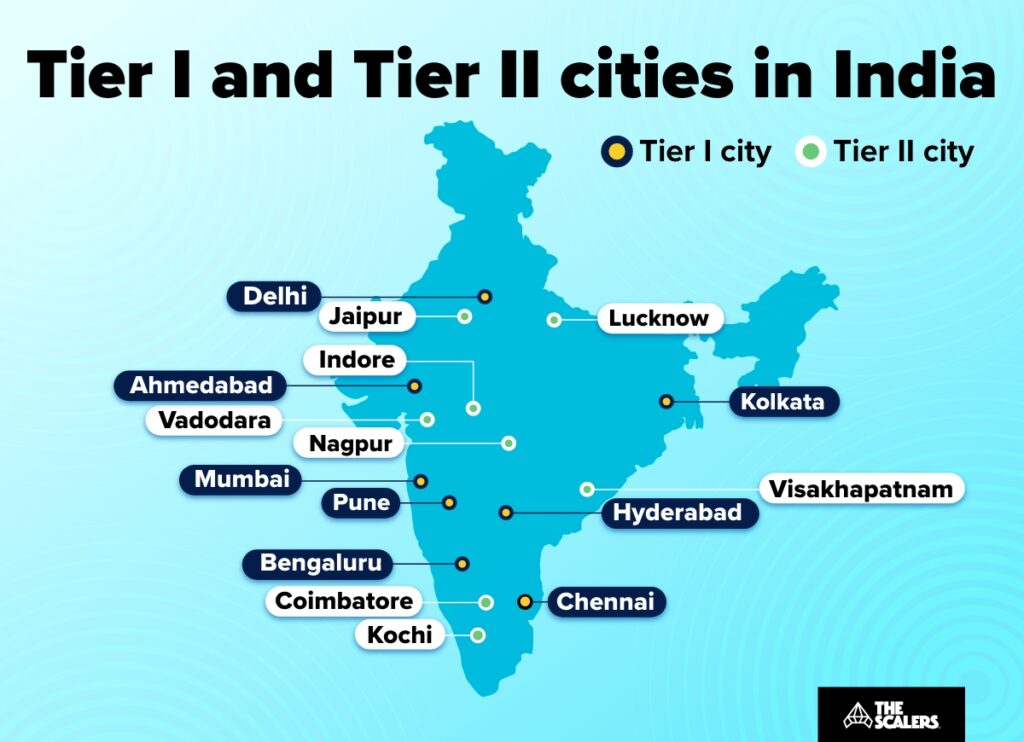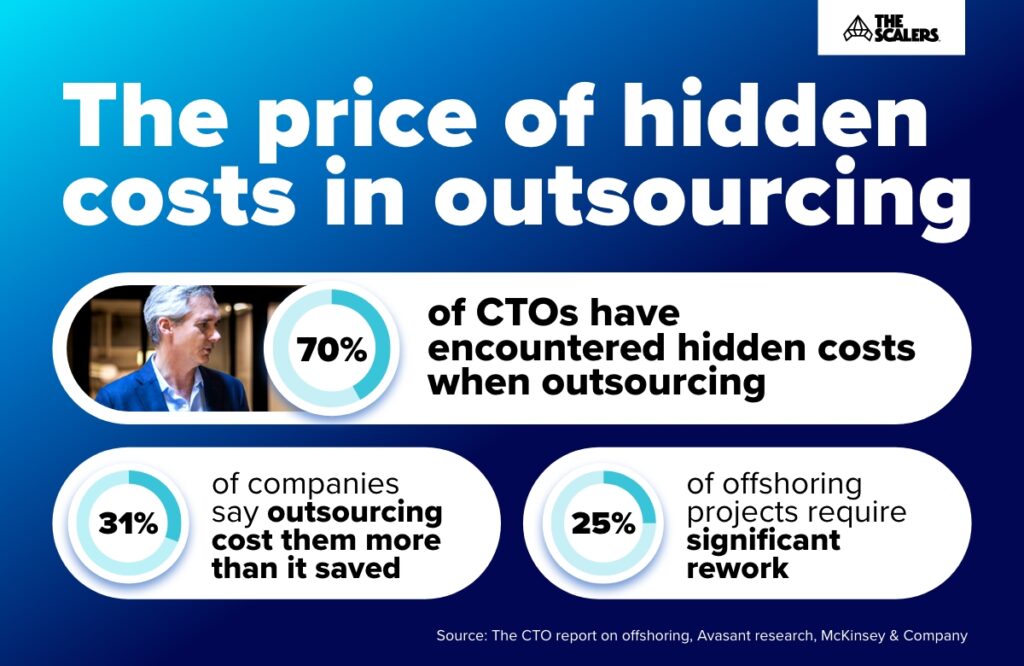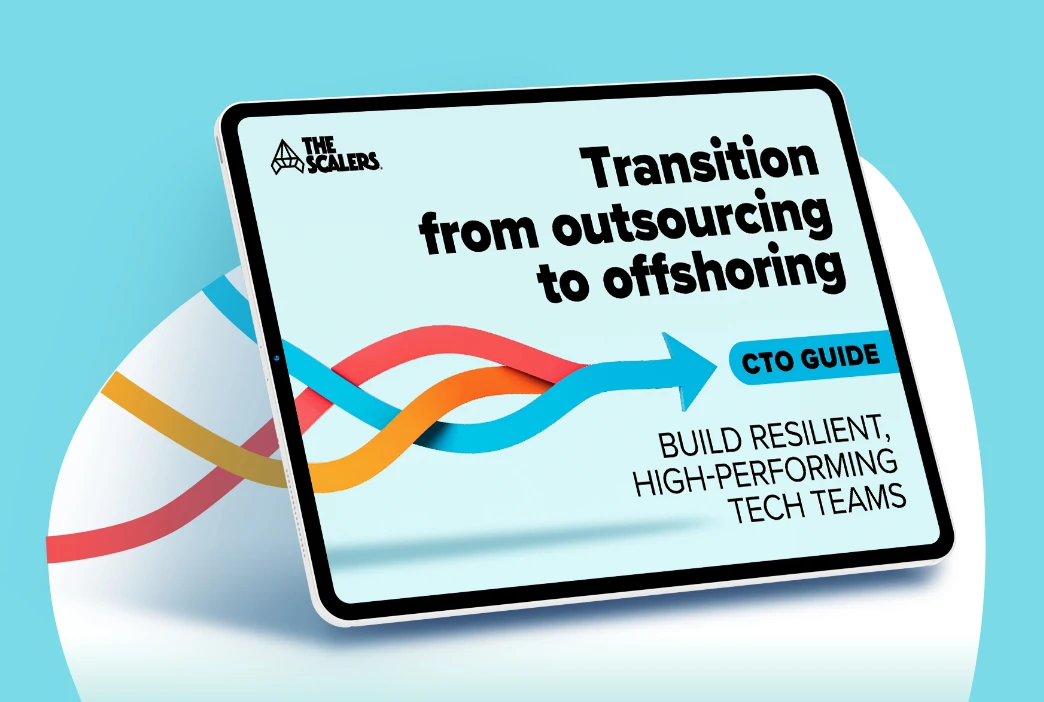If you want to hire from the top 2% of talent in India, you can expect savings of 25-40% on the total costs per engineer. Your exact savings will be determined by the roles, technologies, location, and hidden costs, which makes it difficult to give a precise estimate. These three examples can provide a reference.
- Nextpoint saves $1 million per year with its development team in Bangalore
- Mediolanum saves $940,000 per year with its Bangalore data team
- Preqin saved over £16,790,000 a year with its full office build in Bangalore
Reducing costs isn’t the only reason to move offshore, but it’s in the top three I hear when talking to tech leaders. And even when it isn’t a top factor, they often want to make their budgets stretch further. Both are possible, but giving an exact estimate on how much you could save by offshoring to India depends on a range of factors.
In this article, we’ll highlight the factors that will affect your savings, as well as three real examples of development, data, and full build savings.
How offshoring saves money
Most people focus on the upfront savings you can get from offshoring, but there are also less obvious ways offshoring saves you money. Here are the top ways:
- Lower salaries: Salaries in top offshoring locations are lower than in the US, UK, and Australia. Just be careful about extremely low salaries, as it is a sign of cutting corners.
- Lower overheads: Office space, electricity, water, etc., are all lower in major offshoring hotspots. However, you need to look out for partners who skimp on providing proper facilities to offer lower prices.
- Avoid downtime / follow the sun: Downtime can cost you money and users. Instead of paying local developers overtime, offshore developers can work a 9-5 and prevent these costs.
- Increased productivity: Shipping a new feature or bug fix sooner compounds your return on investment. Companies that deliver frequent updates see a 30% increase in user engagement and an 85% increase in retention compared to infrequent updates (Valeriu Crudu & MoldStud Research Team).
These aren’t the only benefits you get with offshoring, but you need to be wary of the “outsourcing paradox”. This is where you save money up front but pay it back threefold due to redoing work and providing support.

Average developer rate in the UK, Australia, and the US
Salary bands vary dramatically based on experience, speciality, and even the city you hire in. Plus, if your company has less appeal than a rival, you might have to pay more or offer other benefits to incentivise quality candidates to join you (yes, even offshore).
The following data is based on the median salaries of key roles in the main development centres in these countries. This can help you get a ballpark figure to adjust.
| UK | Australia | USA | |
|---|---|---|---|
| Mid-level QA Engineer | $65,000 | $66,000 | $100,000 |
| Mid-level Frontend developer | $80,000 | $85,000 | $100,000 |
| Mid-level Backend developer | $85,000 | $90,000 | $165,000 |
| Mid-level Full-stack developer | $95,000 | $90,000 | $201,500 |
| Site Reliability Engineer | $123,000 | $100,000 | $150,000 |
| Data Engineer | $110,000 | $92,000 | $135,000 |
| AI Engineer | $75,000 | $85,000 | $180,000 |
US data from BuiltIn, UK data from the European Transparent IT Job Market Report 2024 and LevelUp and Australian data from Emanate Technology Salary & Rate Guide 2025.
Note: these are all salaries that employees would receive, rather than fully loaded costs including taxes, visas (the US H1B now costs over $100,000), overheads and other benefits.
Differences between tier I and II cities in India
Tier I cities include Bangalore, Mumbai and Hyderabad. Multinational corporations like Google, Microsoft, Amazon, Meta, SAP, Salesforce, TCS and Adobe all have offices in these tech hubs due to the quality and density of the talent pools. Bangalore leads the way with approximately 25% of India’s tech talent pool, Mumbai is second with 15%, while Delhi sits third at 14% followed closely by Hyderabad with 13% and Chennai at 9%. The other tier I, II and III cities make up the rest at 24% (Nasscom: Talent demand and supply report).

Tier II cities like Pune, Ahmedabad, and Jaipur often lack the infrastructure (internet connection, consistent electrical supply, transport connections, etc.) of their tier I counterparts, and so quality developers seek opportunities in more established tech hubs. Salaries can be 25% cheaper, and rent for office space as much as 75% cheaper, but only if you are willing to compromise on grade, amenities and location.
Before the upfront price difference, there are other factors to consider, like whether you can find enough skilled developers in those cities and if they will stay there or move for a better opportunity elsewhere.
Why our partners choose to go offshore to Bangalore
Admittedly, we are biased about why we believe Bangalore is the best location to set up an offshore team, so we asked our partners and looked at the data to give you an unbiased view.
We knew we wanted to set up in Bangalore as it’s sort of ‘the Silicon Valley of the East’, so we knew we could find the talent we wanted there.
Sirisha’s comment matches what most of our partners say, and the data backs it up.
- Bangalore has over 1.5 million software engineers, the second-largest tech talent pool in the world (after Silicon Valley).
- Each year, 90,000 engineers graduate from Bangalore’s universities.
- It’s home to 14,000 startups and 40 unicorns (Startup Genome).
- Global giants, including Microsoft, Adobe, Apple, Amazon, PayPal, and SAP, all have a presence in the city.
- It has 487 of India’s 1,700 GCCs, more than any other tier I city.
- 70% of our hires have relocated from outside of Bangalore, showing its ability to attract talent that other cities can’t.
While the upfront savings are not as extreme as some Indian cities, the enormous talent pool and ubiquity of Western business practices make it an attractive proposition for many.
What factors might affect my savings from moving offshore?
There are some factors you can influence, and some you can’t. Knowing what they are means you can seek to maximise your savings without sacrificing on quality or making unreasonable compromises.
- Your location: If you’re based in a tech capital like San Francisco, London, Berlin, or Sydney, where salaries and overheads are higher, you’ll save more than if you’re based in Wisconsin, Nottingham, Leipzig, or Adelaide.
- Roles: Full-stack developers will cost more than frontend ones, but hiring a full-stack developer may be cheaper than hiring a frontend and backend one. Some roles have relatively higher or lower salaries in certain countries (for example, QA engineers cost far more in the US and Australia than in the UK), which can affect relative savings a lot.
- Tech stack: Hiring a team of .NET developers won’t break your budget the same way a team of JavaScript ones will. Some legacy tech stacks are more abundant in India, making the savings greater. In contrast, the competition for newer technologies is higher, so the relative savings will be less.
- Seniority and experience: Obviously, more senior positions will cost more, but they offer greater ROI and will need less support.
- Industry-specific experience or skills: If you’re looking for someone with experience in a niche industry like bio-data sampling, it’s going to be more expensive than a generic web developer.
- Overheads/operating model: Some offshore providers focus on cutting any costs they can and, as I’m sure you can guess, sacrifice quality as they do so. Others have higher overheads to make sure they can secure the best talent for their partners. It’s more than just the difference between outsourcing and offshoring, but that’s a good place to start.
All these factors can affect your upfront savings, but there are some other factors you need to consider: hidden costs.
Hidden offshoring costs you need to look out for
Upfront fees are just half the story. Some offshoring providers have (literal) and figurative hidden costs due to their models. You need to make sure you’re not saving when you sign, but then paying down the line.
- Contract lock-in: Maybe you want to scale down your team, or perhaps stop it altogether, as you’ve changed strategy. If there’s a nasty lock-in clause in your contract, you’ll keep paying for no service.
- Jack up rates: Of course, rates are going to go up over time — inflation is a real thing — but some providers will start to squeeze you once they’ve got you.
- Unclear pricing (e.g. additional project management fee): Some offshore providers win deals by advertising massive raw savings only to sneak in a suite of additional fees you never knew you’d have to pay.
- Poor quality work: If your offshore team’s work needs more work to fix, it’s costing you in local development costs.
- Attrition: No developer wants to work for low pay as an anonymous username on another generic outsourcing project. When you pick a provider who operates like this, you can expect high attrition rates leading to project delays.
- Culture misalignment: No, I’m not talking about Dutch directness vs Filipinos’ focus on their families. I’m talking about work culture differences. That can be how they give and receive feedback, but it’s more often about work systems, processes, and documentation. When one team embodies agile, but the other doesn’t, you’re going to pull in different directions.
Some of these are easier to spot upfront; others, not so much. Taking your time to vet partners properly (for example, asking to speak with the real people behind the testimonials on their website) can go a long way.

3 examples of actual savings: Dev team, data team, full office build
It’s hard to show how much you can actually save based on a single employee due to regional differences in salaries and taxes, but the savings possible on a whole team tend to be more relevant. With that in mind, here are three real examples of savings our partners managed to achieve by moving offshore.
Offshore scrum dev team savings: Nextpoint
In May 2022, Nextpoint’s new VP of Engineering started looking for an offshore partner in Bangalore to set up a new offshore team specialising in Ruby on Rails and AWS. This wasn’t primarily a cost-cutting exercise; instead, they were after top-quality developers that they were struggling to find in Chicago. By partnering with The Scalers, they gained a 6-person scrum team, which later scaled to 13 specialists, including a customer support function.
- Team size: 13 experts
- Average saving per role: 55%
- Total team savings: $1 million a year
Nextpoint’s savings were influenced by their less common tech stack, homebase in Chicago, and hiring for QA, Engineering, and Tech Lead positions, all of which influenced their savings.
Offshore data team savings: Mediolanum
More than $45 billion of assets are managed by Mediolanum’s investors each year. To enable their advisors to make better recommendations and deliver new experiences and services to users, they needed to modernise their technology. They partnered with The Scalers to set up a data team that, first, updated and created dashboards to present valuable data to Mediolanum’s staff, then set up enhancements to the underlying platform to deliver deeper insights and more value to users.
- Team size: 16 data scientists
- Average saving per role: 44%
- Total team saving: $940,000 per year
Mediolanum’s team was made up of a mix of Data Engineering roles, QA roles, and Analysts, which, along with their Dublin headquarters, influenced their savings.
Offshore R&D centre savings: Preqin
Preqin was using an outsourcing partner with a team in Pune, India, but wanted more visibility and control over its team. After reviewing different options, they decided to set up a dev team with The Scalers. Impressed with the quick results delivered by their team, they scaled by adding additional development teams before expanding into additional departments. After 4 years, they had more than 450 employees, and Bangalore had become their largest office globally.
- Team size: 450 employees
- Savings on Development profile salaries: £5,280,000 per year
- Savings on the Finance and Marketing team salaries: £510,000 per year
- Savings on Data profiles salaries: £11,000,000 per year
- Total salary savings: £16,790,000 per year
When Preqin’s team exceeded 200 employees and they prepared to set up their own entity in India, they commissioned The Scalers to find and furnish a dedicated office in the heart of Bangalore. This would provide a central hub for collaboration and engagement. Best of all, this 15,000 square foot, dedicated building saved Preqin £360,000 per year compared to their previous arrangement in Bangalore.
The size of Preqin’s operation is obviously the most influential factor in their savings, but due to the multiple roles and departments, it provides a useful reference point for the savings you could expect for a similar operation.
Find out how much you could save by offshoring to India with The Scalers
By now, I’m sure you can see why it’s so hard to give even approximate estimates on how much your company could save by setting up an offshore team. The only way to find out is to get in touch and provide some details, so we can give you a quote for your exact requirements.
So if you’d like to see an estimate for your organisation — based on your stack, team size, and operating model — send me a message. I’ll personally prepare a detailed estimate so you can make an informed decision.
FAQs
To calculate your potential offshore savings, first, you need an accurate picture of how much scaling locally would cost. This is not just local salaries, but benefits and overheads to cover fully loaded costs. Next, you need to get accurate estimates of the cost offshore, which will vary depending on location, required skills, roles, and experience, and the offshoring model you employ. Offshoring providers will share this information, but make sure there aren’t any obscured fees or hidden costs.
Yes, offshore savings generally last for the long run, but it does depend on where you set up an offshore team. Some developing hubs have seen salaries and overheads skyrocket in recent years, reducing cost savings over time. Notably, there are examples of nearshoring teams in Central and Eastern Europe becoming more expensive than development teams in regions of the UK. However, trends take decades to become significant, usually level off, and still provide cost savings.
Setting up an offshore team with a partner who uses a bench can provide you with a team in under a week, but it comes at a cost. You may not have sole use of the developers, lack ownership of the team, and the best developers don’t want to sit on a bench. If your partner hires developers exclusively for you, it can take between a month and four, depending on the rarity of the role. The Scalers typically take between six and eight weeks to set up an initial team.
Build Your Team,
Not Just a Contract








